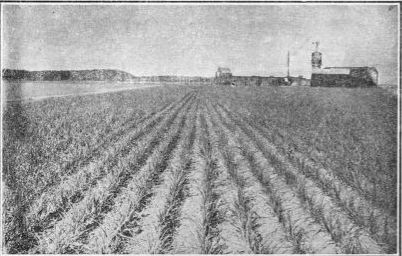538. Cultivation Of Onion
Description
This section is from the book "Vegetable Gardening", by Ralph L. Watts. Also available from Amazon: Vegetable Gardening.
538. Cultivation Of Onion
As the onion is a shallow-rooted plant, care must be taken not to injure the roots by deep tillage. When hard rains incrust the soil before seeds have germinated, light raking or rolling will be an advantage. Horse cultivators are sometimes employed, especially in the heavier soils, which are difficult to work by hand. However, the additional spacing between rows, required for horse tillage, necessarily limits the yield. If ground has been properly prepared, there will be few instances when the rows should be more than 1 foot apart. Hand wheel hoes must then be employed in cultivating. Both single and double wheel types are in common use, but it is more economical to use double than single wheel hoes when the plants are small. Many growers prefer the single wheels at all stages of growth. Straight rows and uniform spacing are a great advantage in the operation of wheel hoes. The vertical shovels or teeth are most useful in heavy soils, while the horizontal sweeps are most serviceable in light soils. The latter attachments may be used without danger of covering the small plants. It is necessary to cultivate from 8 to 15 times during the season.
Hand weeding and thinning are required. This work is often done by boys and girls. The thinning is usually performed at the first weeding, when 8 or 10 plants are allowed to the linear foot of row, but in very good soils and when large bulbs are desired, the plants should stand about 2 inches apart. Special hand weeders (Figure 7) are in common use. Both weeding and thinning should be avoided as much as possible by the proper preparation of the soil and the adjustment of drills. Figure 92 shows a well-managed onion field on Long Island.

Fig. 92. field of onions on long island.
539. Irrigation
In many sections of the West and the Southwest onions cannot be grown without irrigation, the ground being too dry to supply the moisture necessary. All of the Bermuda onions of the Southwest are grown under irrigation. The land is flooded before planting and afterwards at intervals of a week or 10 days until the bulbs are full sized, when water is withheld to induce ripening. An increasing number of growers in various parts of the country are employing the overhead system of irrigation, which is ideal when applied to this crop. Sprinkling before or after planting prevents the blowing of muck and sandy soils and the accompanying disastrous results in young plantations. Irrigation increases yields and insures the crop against loss from drouth.
Continue to:
Tags
plants, crops, gardening, cultivated, harvesting, food ,greenhouses, fertiliser, vegitables
